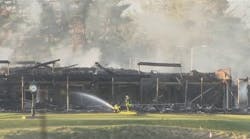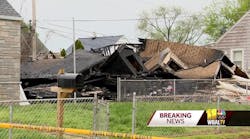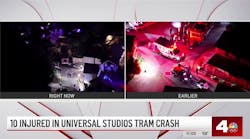Sources of wildland firefighting information such as the FireLine Handbook (FLHB), Incident Response Pocket Guide (IRPG), S-215 Wildland Urban Interface Workbook (S-215) and Suppression Tactics Reference Guide, all publications of National Wildfire Coordinating Group (NWCG), contain terminology, strategy and tactics that are in need of updates, changes or both.
Let's begin with the wildland/urban interface (WUI) description of categories of threatened structures from the FLHB, S-215 Workbook and the Wildland Fire Suppression Tactics Reference Guide:
- Needing little or no attention for now
- Needing protection, but savable
- Indefensible
These appear to be definitions of categories without indicating an action, resulting in firefighters creating terms such as "loser," "write-off" and "toast."
Following the "Calabasas Fire" burnover of Glendale and Los Angeles firefighters in 1996, and having the honor of leading the investigation, the following terminology, strategies and tactics have evolved and have been shared with many firefighters in California, Idaho and Montana.
In refining categories of structures threatened on WUI fires, several firefighters have contributed descriptive terms that indicate a course of action — Battalion Chief (ret.) Mike Sandeman and Captain Gary Harris of the Los Angles County Fire Department; and Deputy Chief Mario Rueda and Battalion Chief (ret.) Don Stukey of the Los Angeles Fire Department. In addition, the U.S.D.A. Forest Service's Jim Cook and the staff at the National Interagency Fire Center (NIFC) in Boise, ID, deserve credit for updating and improving the LCES (Provide lookouts, Communications, Escape route to a Safety zone) flowchart (see page 134). LCES was developed by the late Paul Gleason, a retired U.S.D.A. Forest Service Hotshot superintendent, to provide safety for a fire crew using three of the 10 Standard Fire Orders.
WUI Strategy & Tactics
Use available resources to safely protect human-made improvements that are in the path of a wildland fire. The primary strategy in the wildland urban interface is the safety of firefighters. Establishing a safety zone for firefighters and apparatus before committing to defend a structure will enable the firefighters and apparatus to remain in the safe area as the firefront arrives and passes.
The first consideration in a fire behavior estimate is to base all actions on current and expected fire behavior. To estimate fire behavior between the structure(s) to be protected and the firefront, combine current and expected fire activity, fuel bed, weather components, aspect and time with the terrain features that may or may not affect fire spread. (See IRPG, page 2, Look up, Down and Around, and update regularly.)
Commit to protect a structure only if a safety zone for the firefighters and apparatus is present at the structure. Here's how to define a safety zone for firefighters and apparatus:
- The apparatus will not be damaged, (no light, window or paint damage)
- Firefighters will not have to deploy their shelters. (See Safety Zone for Firefighter, FLHB, page 12. The safety zone is "a pre-planned area of sufficient size and suitable location that is expected to protect fire personnel from known hazards without using fire shelters."
Characteristics of a safety zone for firefighters and apparatus:
- Cleared areas, greenbelts, space, terrain and structural barriers
- Areas where flame length(s), convective or radiated heat will not adversely impact the safety zone
Structure Size-Up/Triage
The most important static size-up considerations are:
- Location of the structure terrain-wise
- Terrain between the structure and the current and expected fire front
- Fuel bed
- Defensible space
The WUI non-static components and structural considerations include ornamental/decorative vegetation, homeowners collection of stuff, weather components, narrow access roads, unknown bridge limit, non-insulated power lines (see IRPG, pages 12-13, on power line safety), roof construction, exterior siding, vent openings, LPG tanks (the primary concern is extended exposure to direct heat) and septic tanks. Also, perform a size-up for potential hazardous materials, especially in garages, storage sheds or work buildings. However, firefighters are able to safely defend structures with these challenges.
Narrow canyon bottoms and mid-slope structures with fire coming from a lower elevation are extremely hazardous and will require additional defensible space. A mid-slope structure may or may not be used as a barrier, depending on the roadway/driveway location and defensible space.
The four categories of structures are:
- Defensible/LCES available/fire agency staffed — The determining factor is that a safety zone for apparatus and firefighters is at or near the structure. The structure has a higher probability of ignition without firefighter intervention.
- Defensible/stand-alone/LCES available/patrol status or homeowner protected — Again, the determining factor is that a safety zone for apparatus and firefighters is at or near the structure. In this case, the structure requires little or no attention. However, no structure in the path of a wildfire is truly without the need of protection, resulting in the requirement of fire agency patrol status or the presence of the homeowner to protect the property. The U.S. Constitution gives a homeowner the right to defend his or her property, and in many areas fire agencies are teaching leave early or prepare, defend and shelter in place.
- Non-defensible/"Prep and go!" — No safety zone is present. However, if time allows, light mitigation may be performed, such as applying foam or gel retardants. Mitigation involves minor preparation such as moving lawn furniture and small combustibles; it does not mean brush clearance, tree trimming or moving firewood piles. Pre-incident preparation is the responsibility of the homeowner.
- Non-defensible/"Rescue-drive-by" — No safety zone is present. If time allows, ensure that life is not present in the threatened structure. Look for "latchkey children" and disabled persons who must not be left behind or missed. Consider forced entry.
"Prep and go" and "rescue drive-by" are based on the fire behavior estimate that adequate time is available to safely prepare and complete rescue operations without being entrapped. Go to the closest safety zone, allowing the fire to go by, and then follow the fire back into the area of the "prep and go" and "rescue drive-by" structures.
Structure protection tactics include:
- Triage before protection
- Safety zone for firefighters and apparatus
- Light mitigation
- Use garden hose, one-inch, 1½-inch or 2½-inch hose, or monitors for local government fire agencies if required to knock down fire in fully involved structures with fire spreading from one structure to another.
- Have a protection line charged
- Secure a backup source of water; i.e., garden hose(s), swimming pools, ponds, private water tanks or hydrants. Keep at least 100 gallons in reserve.
- Remember, there is safety in water, but never bet firefighter safety on a water source.
- Preparing a written pre-plan, including maps, water sources, safe areas and staging before an emergency will assist in a safer incident.
My objective is that firefighters will use the LCES flowchart and the above guidelines to perform in a manner that will prevent firefighter injuries.
Next: How to make a fire-behavior prediction or estimate on a wildland fire.
JP HARRIS is a battalion chief (ret.) with the Los Angeles County, CA, Fire Department, where he served for 38 years. For 10 years, he trained crew supervisors and superintendents in firing operations as part of the Los Angles County Fire Department Prescription Burn Program. Harris also has taught numerous wildland firefighting classes to career and volunteer firefighters, and he created the five-volume "Wildland Video Series."





